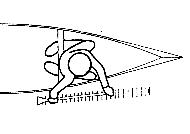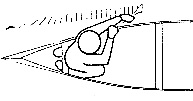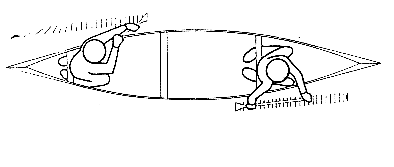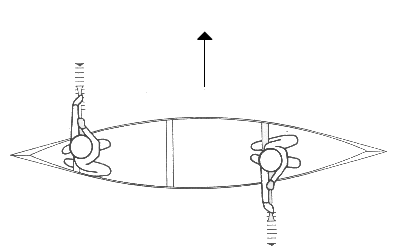|
Movement
Basic Strokes:
Bow Stroke - This stroke is used to move the canoe forwards in a
straight line. The stroke itself is simple. The paddler reaches forwards
and places the paddle in the water. The paddle is then drawn towards the
stern, in a line parallel to the keel. To recover the paddle is lifted from
the water and swung forward in a circular motion. If done in reverse this
will propel the canoe backwards.

Canadian Stroke - If the bow and stern men both do the bow stroke the
canoe will turn slowly due to the leverage created by the paddlers. To
correct for this the sternman uses the Canadian stroke. This is essentially
the same as the bow stroke, except the blade is pushed slightly away from
the side of the canoe at the end of the stroke. This counteracts the
leverage created by paddling. The sternman will need to use the Canadian
stroke once for every three to four bow strokes in order to maintain a
straight course.

J-Stroke - This is a more sever form of the Canadian stroke, which is
used by the sternman to turn the canoe towards the side that the sternman is
paddling on.

Draw - This stroke is done by extending the paddle outwards, and
drawing towards yourself. If this is done on opposite sides of the canoe by
both the paddlers the canoe will rotate rapidly. If this is done on the
same side by both paddlers the canoe will move sideways.

Pry/Push away - This is the opposite of the draw. The paddle is
inserter into the water by the canoe, and pushed outwards. This has the
same effect as the draw, but the result will be in the opposite direction.

Check - This is a simple stroke used for stopping. Simple insert
the paddle in the water beside the canoe and hold it in place. This will
slow the canoe.
Sweep - This stroke turns the canoe in a circle away from the
paddling side of the canoe. To do this stroke place the paddle in the water
as far in front of you as you can. Pull the blade in a wide semicircle
until the paddle is behind you. This can also be done in the reverse
direction, which will rotate the canoe towards the paddling side.

Putting it Together:
Going Strait - To go in a strait line the bowman should use the
bow stroke, and the sternman should use the bow stroke, with enough Canadian
stokes mixed in to keep the canoe traveling in a straight line.

Weak Turns - To make a weak turn towards the bowman's paddling side
several Canadian strokes can be used in a row. To turn away from the
bowman's paddling side the sternman can stop using Canadian strokes, or
curve his/her stroke towards the keel.
Medium Turns - To make a medium turn sternman can use a 'J' stroke on
the appropriate side of the canoe, while the bowman maintains the bow
stroke. The sternman can also use short draws and pry's to make medium
turns.

Strong Turns - To make strong turns several things can be done.
The sternman can use pry's and draws to move the stern rapidly. The bowman
can use prys and draws to move the bow rapidly, or both paddlers can use
combinations of these strokes to achieve a strong turn.
Moving Sideways - There are three ways to move a canoe
sideways. The first is for both paddlers to use a draw on the same side of
the canoe. This will draw the canoe towards the paddling side. This is
good for moving sideways towards an object.
The second method involves both paddlers using pry's on the same side of
the canoe. Controlling the canoe is difficult when doing this, but it is
good for bringing the canoe alongside a dock or another canoe.
The final method relies on one person using a draw, and the other a pry,
on opposite sides of the canoe (see picture below). This is good for
situations where the canoe needs to be moved sideways when there is not
enough time for one paddler to switch sides, and a turn is impractical (i.e.
dodging a rock in white water).

Rotating - There are two way's to rotate in place. The first is
for both paddlers to draw or pry on opposite sides of the canoe. This will
rotate the canoe in the direction of the pry/draw. The second method
involves using the sweep stroke on opposite sides of the canoe. This will
rotate the canoe in the direction of the sweeps.
Techniques:
Entering the Canoe - Although this seems like it should be simple,
its not. If you are not careful you'll flip the canoe and end up in the
drink! To properly enter into the canoe take your paddle and place it
across the gunwales. Next place one foot directly onto the keel, and shift
your weight so it is directly over the keel. Now bring your other foot
into the canoe and place it as near to the center as you can. Slowly lower
yourself into a kneeling position and you're done. To exit the canoe
reverse this procedure.
Posture - Although canoes have seats you're not supposed to sit on
them as you would a seat. If you were to do this you're center of gravity
would be too high and the canoe would be prone to tripping. Instead you
kneel on the bottom of the canoe and rest your behind on the seat. This
lowers your center of gravity. This can be hard on the knees, so its a good
idea to have some sort of pad to kneel on.
The Bowman - The bowman's role is to look out for objects and to
fallow the sternmans instructions.
The Sternman - The sternman role is to guide the canoe, which
includes telling the bowman what strokes to use.
Do's and Don'ts:
-Do wear a PFD (life jacket). Even if your a good
swimmer these can save your life.
-Don't stand in a canoe (it'll tip).
-Do pack a change of clothes, shoes, and a towel
in a waterproof bag - incase you take a dip.
-Don't canoe in a lighting storm - you'll get
nuked.
-Do wear sunscreen - you'll burn even if it's
cloudy.
-Don't drink alcohol while canoeing.
-Do drink lots of fluids and eat while canoeing .
-Don't forget to have fun!
|
 |
|
Canoeing Terms, Choosing a Canoe, and
Paddles
|
|